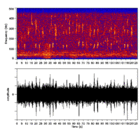- Baffles (submarine)
-
"Baffles" redirects here. For other uses, see Baffle (disambiguation).
The baffles is the area in the water directly behind a submarine or ship through which a hull-mounted sonar cannot hear. This blind spot is caused by the need to insulate a sonar, commonly mounted near the bow, from the noise of the vessel's machinery.
Following a vessel by hiding in its baffles was a common submarine surveillance technique during the Cold War, which led to the tactics of "clearing the baffles". Variants of this technique include the "Crazy Ivan", a baffle-clearing manoeuvre intended to bring the followed submarine onto an attack heading and typically used by the Soviet Navy, and "Angles and Dangles", a five-hour process of rapid direction and speed changes to ensure a submarine was not emitting any noise. Following a vessel in its baffles was dangerous, because of the high risk of collision.
Following the development of towed-array sonar, which negated the baffles blind spot, such tactics fell out of use.
Contents
Background and etymology
Since a sonar array is extremely sensitive to underwater sounds, it must be protected from the noise generated by machinery on the vessel on which the sonar is installed. Otherwise, its own noise would tend to drown out other sonar targets. To reduce noise, sound-attenuating material is placed between the sonar and the rest of the vessel. This makes the sonar much more effective, but causes a blind spot where this material is: as most hull-mounted sonars are located at the front of the vessel, the resulting blind spot is located directly behind the vessel.
The term baffles is likely derived from a lesser used definition of the word itself, that of "a partition that prevents interference between sound waves in a loudspeaker." In the instance of its usage in terminology pertaining to submarines the definition can be expanded and slightly modified to "an area behind the submarine that due to the cavitation and the wake left by the propulsion system impedes the ability for on-board sonar systems to accurately establish what, if anything, is behind the submarine."
Clearing the baffles
A submarine tracking another submarine can take advantage of its quarry's baffles to follow at a close distance without being detected. Periodically, a submarine will perform a maneuver called clearing the baffles, in which the boat will turn left or right far enough to listen with the sonar for a few minutes in the area that was previously blocked by the baffles. Good tactics require a submarine to clear the baffles at irregular intervals and in different directions so that a pursuing submarine cannot predict when and how the next baffle-clearing maneuver will be made. When a submarine clears its baffles, a pursuing submarine must take measures to avoid detection, or worse, collision, with the submarine ahead.
In some cases, submarine commanders could choose to clear the baffles by executing one or a series of hard turns in order to not only clear the baffles, but also be in a favorable position to attack the potentially following submarine. Such extreme maneuvers were more commonly used by Soviet Navy submarines during the Cold War than by other forces, leading to the maneuver's nickname: "Crazy Ivan". The "crazy" came from the danger such a maneuver posed to both submarines, first being detection of the following submarine, which was commonly avoided by stopping the engines and going to maximum silence, and secondly by collision, as the momentum of the pursuing boat could result in collision with the leading submarine; dead ahead in the process of turning sharply. Unsurprisingly, the "Ivan" comes from the "generic" name for a Russian male, as thought of by many Westerners.
A similar baffle-clearing maneuver is known as "Angles and Dangles": a five-hour series of random figure eights, sharp turns, and random depth changes. The maneuver is executed at the start of a voyage, in order to determine if the submarine is making any detectable noise.
Most present-day submarines and ships carry a towed array sonar: a sonar mounted on a long cable let out behind the vessel. This can pick up sounds in the area behind the baffles, reducing the need for baffle-clearing maneuvers.
References
- Sontag, Sherry; Drew, Christopher; Drew, Annette Lawrence (1998). Blind Man's Bluff: The Untold Story of American Submarine Espionage. Harper. ISBN 0-06-103004-X.
- Crazy Ivan: A True Story of Submarine Espionage by W. Craig Reed, William Reed, (ISBN 0-595-26506-5)
External links
Sonar 
Ocean acoustics Acoustic ecology Categories:- Submarines
Wikimedia Foundation. 2010.

